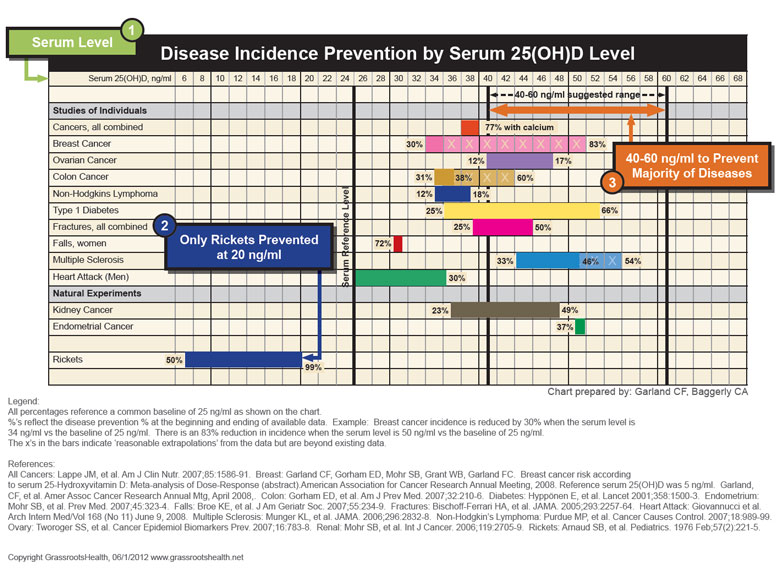Cancer
Lower Vitamin D Levels Predict Poor Survival Outcomes in Melanoma

03/2016
By Dave Levitan
In patients with melanoma, lower 25-hydroxyvitamin D (vitamin D) levels were associated with poorer survival outcomes, according to a prospective study. This association was independent of C-reactive
protein (CRP) levels.
“Vitamin D has anti-inflammatory properties, has antiproliferative effects on melanoma cells, can inhibit tumor growth and tumor invasiveness, and promotes melanoma cell DNA repair,” wrote study authors led by Jeffrey E. Lee, MD, of the University of Texas MD Anderson Cancer Center in Houston. Studies on intake or blood levels of vitamin D and melanoma risk, however, have yielded inconsistent results.
In the new study, researchers conducted a prospective analysis that accounted for important confounders including CRP, which is a marker of inflammatory response that is associated with melanoma outcomes. The study included 1,042 melanoma patients; the results were published online ahead of print in the Journal of Clinical Oncology.
Vitamin D levels were considered sufficient if they ranged between 30 and 100 ng/mL. Overall, the median level in this cohort was 25 ng/mL, and 24.6% of patients had a vitamin D level below 20 ng/mL. Levels did not vary significantly over increasing time from diagnosis.
Several factors were significantly associated with vitamin D levels. They were higher when blood was drawn in the spring or summer compared to fall or winter (26.39 ng/mL vs 23.59 ng/mL; P < .001), and lower with increasing patient age and increasing CRP levels. Patients with an ulcerated primary tumor and with advanced disease also had lower vitamin D levels.
On a multivariate analysis that adjusted for age, sex, disease stage, blood draw season, and CRP, vitamin D levels remained significantly associated with survival outcomes. The hazard ratio (HR) for overall survival was 1.02 per unit decrease of vitamin D (95% CI, 1.01–1.04; P = .005). Similarly, the HR for melanoma-specific survival was 1.02 per unit decrease (95% CI, 1.00–1.04; P = .048), and 1.02 for disease-free survival (95% CI, 1.00–1.04; P = .04327).
Using 20 ng/mL as a clinical cutoff, those with deficient vitamin D levels had a significantly poorer OS than those above that mark, with an HR of 1.44 (95% CI, 1.13–1.85; P = .0036). The same was true for melanoma-specific survival, with an HR of 1.37 (95% CI, 1.00–1.87; P = .0475), but not for disease-free survival, with an HR of 1.12 (95% CI, 0.77–1.62; P = .5644). A further analysis showed that using 16 ng/mL might be the best clinical cutoff point for vitamin D levels.
“The current investigation is the first, to our knowledge, to report a significant, independent association between lower vitamin D levels and poorer melanoma survival after adjustment for the influence of the [systematic inflammatory response] through simultaneous measurement of CRP,” the authors concluded. “A coordinated investigation of the mechanisms responsible for the independent association of these two important inflammatory biomarkers with outcomes in patients with melanoma is likely to be clinically relevant and may have implications for other cancers.”
http://www.cancernetwork.com/melanoma/lower-vitamin-d-levels-predict-poor-survival-outcomes-melanoma
By Dave Levitan
In patients with melanoma, lower 25-hydroxyvitamin D (vitamin D) levels were associated with poorer survival outcomes, according to a prospective study. This association was independent of C-reactive
protein (CRP) levels.
“Vitamin D has anti-inflammatory properties, has antiproliferative effects on melanoma cells, can inhibit tumor growth and tumor invasiveness, and promotes melanoma cell DNA repair,” wrote study authors led by Jeffrey E. Lee, MD, of the University of Texas MD Anderson Cancer Center in Houston. Studies on intake or blood levels of vitamin D and melanoma risk, however, have yielded inconsistent results.
In the new study, researchers conducted a prospective analysis that accounted for important confounders including CRP, which is a marker of inflammatory response that is associated with melanoma outcomes. The study included 1,042 melanoma patients; the results were published online ahead of print in the Journal of Clinical Oncology.
Vitamin D levels were considered sufficient if they ranged between 30 and 100 ng/mL. Overall, the median level in this cohort was 25 ng/mL, and 24.6% of patients had a vitamin D level below 20 ng/mL. Levels did not vary significantly over increasing time from diagnosis.
Several factors were significantly associated with vitamin D levels. They were higher when blood was drawn in the spring or summer compared to fall or winter (26.39 ng/mL vs 23.59 ng/mL; P < .001), and lower with increasing patient age and increasing CRP levels. Patients with an ulcerated primary tumor and with advanced disease also had lower vitamin D levels.
On a multivariate analysis that adjusted for age, sex, disease stage, blood draw season, and CRP, vitamin D levels remained significantly associated with survival outcomes. The hazard ratio (HR) for overall survival was 1.02 per unit decrease of vitamin D (95% CI, 1.01–1.04; P = .005). Similarly, the HR for melanoma-specific survival was 1.02 per unit decrease (95% CI, 1.00–1.04; P = .048), and 1.02 for disease-free survival (95% CI, 1.00–1.04; P = .04327).
Using 20 ng/mL as a clinical cutoff, those with deficient vitamin D levels had a significantly poorer OS than those above that mark, with an HR of 1.44 (95% CI, 1.13–1.85; P = .0036). The same was true for melanoma-specific survival, with an HR of 1.37 (95% CI, 1.00–1.87; P = .0475), but not for disease-free survival, with an HR of 1.12 (95% CI, 0.77–1.62; P = .5644). A further analysis showed that using 16 ng/mL might be the best clinical cutoff point for vitamin D levels.
“The current investigation is the first, to our knowledge, to report a significant, independent association between lower vitamin D levels and poorer melanoma survival after adjustment for the influence of the [systematic inflammatory response] through simultaneous measurement of CRP,” the authors concluded. “A coordinated investigation of the mechanisms responsible for the independent association of these two important inflammatory biomarkers with outcomes in patients with melanoma is likely to be clinically relevant and may have implications for other cancers.”
http://www.cancernetwork.com/melanoma/lower-vitamin-d-levels-predict-poor-survival-outcomes-melanoma
